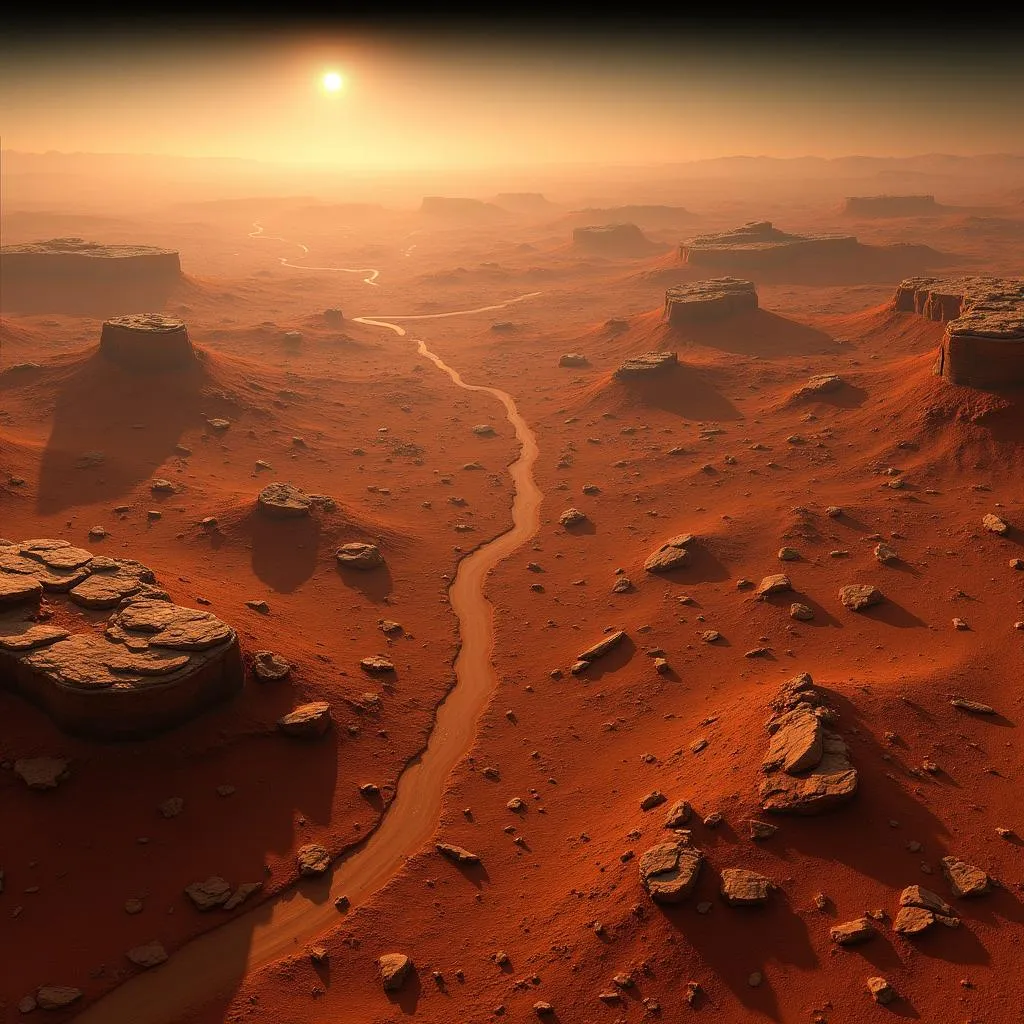From the fiery glow of Venus to the cool blue of Neptune, our solar system is a vibrant tapestry of colors. Ever wondered what color is the planets in our cosmic neighborhood? Let’s embark on a journey to explore the unique hues that paint our celestial canvas.
The Colors of the Inner Rocky Planets
The inner planets, primarily composed of rock and metal, showcase a fascinating range of colors influenced by their composition and atmospheres.
Mercury: Grayish and Cratered
Mercury, the smallest and closest planet to the Sun, appears as a grayish world dotted with countless craters. Its thin atmosphere, known as an exosphere, doesn’t significantly impact its color. The gray hue arises from the abundance of iron and other dark minerals on its surface.
 Surface of Mercury
Surface of Mercury
Venus: Yellowish with a Sulfuric Acid Haze
Venus, often called Earth’s twin due to its similar size, is shrouded in a thick atmosphere composed mainly of carbon dioxide. This dense atmosphere traps heat, making Venus the hottest planet in our solar system. When observed from space, Venus appears bright yellow. This yellowish tinge is attributed to the presence of sulfuric acid clouds in its atmosphere, which absorb blue light and reflect yellow.
 Venus's Atmosphere
Venus's Atmosphere
Earth: A Vibrant Blue Oasis
Our home planet, Earth, stands out as a vibrant blue sphere when viewed from space. This distinctive color comes from the vast oceans that cover approximately 70% of its surface. Water molecules effectively absorb longer wavelengths of light (red and orange) while scattering shorter wavelengths (blue and green). The presence of clouds further enhances the blue appearance by reflecting sunlight.
Mars: The Red Planet
Mars, aptly nicknamed the “Red Planet,” displays a striking rusty red color due to the prevalence of iron oxide (rust) on its surface. This iron oxide is believed to have formed through a combination of water and atmospheric oxygen in the distant past.
 Martian Surface
Martian Surface
The Outer Gas Giants: Hues of Gas and Ice
The outer planets, composed primarily of gas and ice, exhibit a different set of colors compared to their rocky counterparts.
Jupiter: Bands of Brown, Orange, and White
Jupiter, the largest planet in our solar system, showcases a mesmerizing pattern of brown, orange, and white bands. These bands result from the dynamic movement of different gases in Jupiter’s atmosphere, including ammonia ice, water vapor, and ammonium hydrosulfide. The Great Red Spot, a massive storm larger than Earth, adds a striking red hue to Jupiter’s swirling canvas.
Saturn: Pale Yellow with Hints of Gold
Similar to Jupiter, Saturn is a gas giant with a predominantly pale yellow color. This hue arises from the presence of ammonia ice crystals in its upper atmosphere. Traces of other elements, like phosphorus and hydrocarbons, contribute subtle hints of gold and other colors to Saturn’s overall appearance.
Uranus: An Icy Blue Giant
Uranus, an ice giant, appears as a pale blue-green color. This distinctive hue is attributed to the presence of methane in its atmosphere. Methane absorbs red light from the Sun, scattering blue and green light back into space.
Neptune: Deep Blue with Hints of Azure
Neptune, the farthest planet from the Sun, shares a similar blue hue with Uranus due to the presence of methane in its atmosphere. However, Neptune appears a deeper blue due to the presence of other yet-to-be-identified compounds that absorb longer wavelengths of light.
Exploring the Colors of Our Solar System
Understanding the colors of the planets provides valuable insights into their composition, atmospheres, and evolution. By studying these celestial hues, scientists can unravel the mysteries of our solar system and beyond.
If you’re interested in learning more about the cosmos, explore our article about what color stars are the coolest!
Frequently Asked Questions about Planet Colors
Why is Pluto not included in this list?
Pluto, reclassified as a dwarf planet in 2006, possesses a brownish hue. Its surface is covered in various ices, including nitrogen, methane, and carbon monoxide, which contribute to its overall color.
Do the colors of the planets change over time?
Yes, the colors of some planets can vary over time. For instance, the intensity of the Great Red Spot on Jupiter has been observed to change over the years.
What is the most colorful planet in our solar system?
Jupiter, with its vibrant bands of brown, orange, and white, is often considered the most colorful planet in our solar system.
Need Help Choosing Colors for Your Own Space?
Contact Color Box Hà Nội at 0373298888, email us at [email protected], or visit us at 86 Cầu Giấy, Hà Nội. Our team is available 24/7 to help you create a living space as vibrant and unique as the planets themselves!

